By: Bart Gazzola
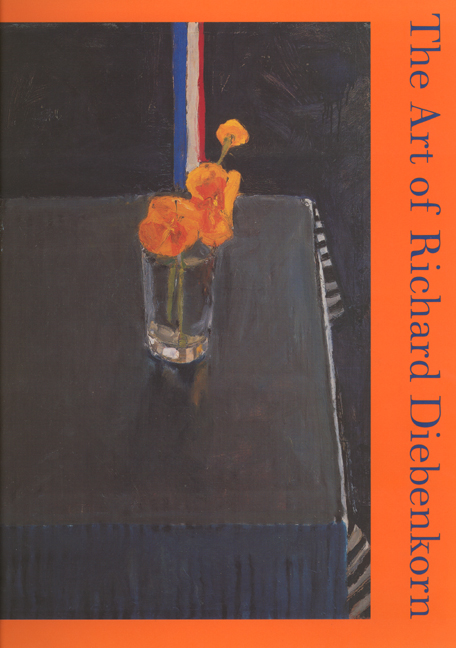
The Art of Richard Diebenkorn
December 18, 2021The Art of Richard Diebenkorn, 1997
Jane Livingston, with essays from John Elderfield and Ruth Fine (The University of California Press)
Forgive me for saying something positive about social media, but it’s allowed for a proliferation of art and images online (which is one of the motivating factors that helped create the Covert Collective); the art historian in me welcomes this, as on Twitter, for example, there’s numerous ‘art bots’ that have filled the sphere with many fine artworks – such as those of Richard Diebenkorn.
“Recognized as a major figure in postwar American painting, Richard Diebenkorn (1922-1993) was an artist strongly identified with California but whose work is beloved throughout the United States and the rest of the world. This catalog is the most comprehensive volume on the artist now available.
Jane Livingston’s extensively researched biographical essay covers Diebenkorn’s entire career and concentrates on the artist’s inner life and purposes as revealed in his paintings. Ruth Fine deals primarily with the figurative aspect of Diebenkorn’s work (1955-67), and John Elderfield concentrates on the Ocean Park period (1967-93). All three authors provide valuable insights based on their personal relationships with the artist and his widow, Phyllis. On both page and canvas, the reader can sense Diebenkorn’s complexity and highly self-conscious working methods, as well as his formidable integrity.
The Art of Richard Diebenkorn will give readers with an interest in all phases of modernism new thoughts about the relationship between abstraction and representation. Stunningly illustrated, with 192 full-color reproductions, this book is an exhilarating testament to a distinctive American artist.” (from the publisher, The University of California Press)
The essays are enjoyable and informative: but the majority of the book is defined by almost 200 full-colour reproductions and that’s why I recommend this book. From Diebenkorn’s still life paintings to his rough portraits to his ephemeral repeated meditations where place and abstraction intersect, this book is rife with beautiful images. “If painting doesn’t offer a way to dream and create emotions, then it’s not worth it”, to quote Pierre Soulages, a contemporary to Diebenkorn, and one can easily get lost among the many images of Diebenkorn’s in this book
This is hopefully to be found at your library (UC Press offers a space to request a copy for the same), or your locally owned bookstore. Since I mentioned social media in this Library suggestion, it would be remiss to not offer links to a Richard Diebenkorn #artbot on Twitter, as a teaser to encourage you to seek out this book.
~ Bart Gazzola
Read More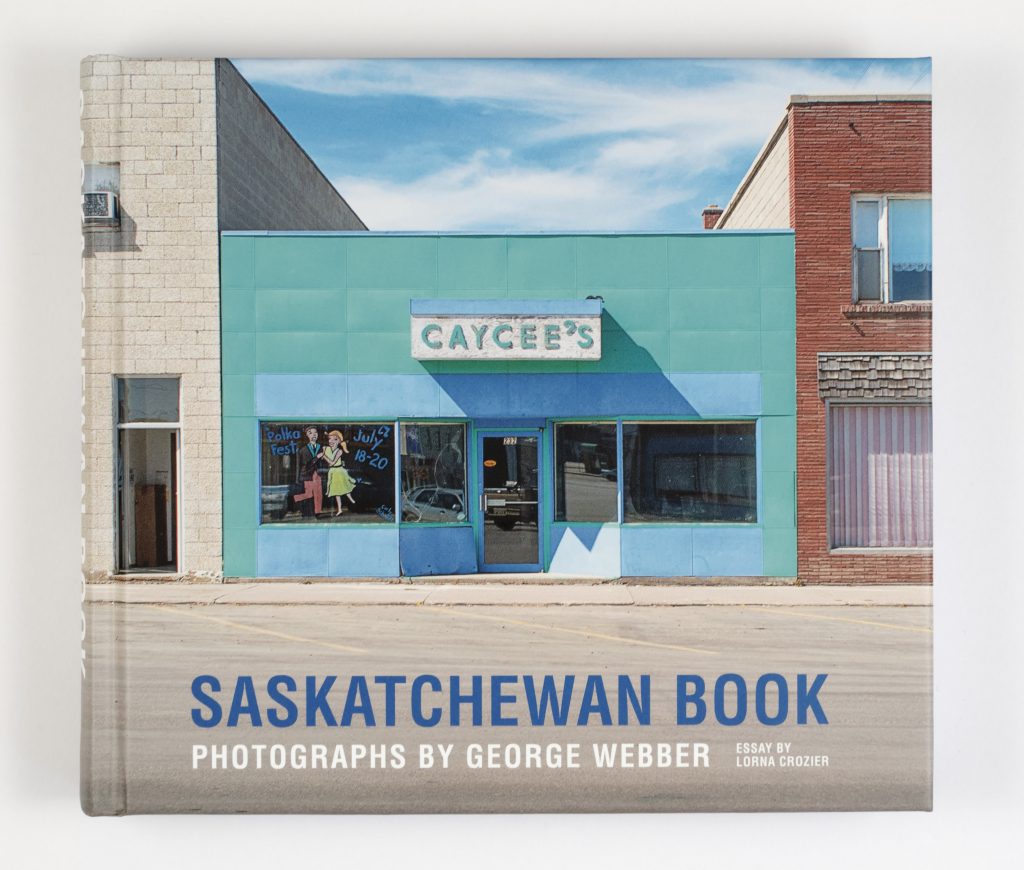
Saskatchewan Book: Photographs by George Webber
December 3, 2021Saskatchewan Book: Photographs by George Webber
Text by Lorna Crozier, Hardcover, 2020, 320 pages, $45.
Intentionally or not, the photographs George Webber made of rural Saskatchewan over the course of 30 years form a landscape typology. Beautifully portrayed in colour, his eye returns again and again to familiar prairie themes that invite comparison: faded signs, buildings in need of TLC (or more), and details of abandoned items left to decay. Although the particulars may change from scene to scene, there is an unavoidable thread that runs through the book: the wide-open skies of the prairies might go on forever, but traces of human settlement fade. You would not guess from Saskatchewan Book that the province has cities or that its population is growing. Instead, with every frame, Webber evokes memories of a way of life in a countryside eclipsed by urban living. It is an affectionate lament for the past.
Saskatchewan Book: Photographs by George Weber can be purchased here, at rmbooks.com.
Image + book review by Alan Bulley / @alanbulley
~ Rita Godlevskis
Read More
The Quilts of Gee’s Bend: Masterpieces from a Lost Place
November 5, 2021The Quilts of Gee’s Bend: Masterpieces from a Lost Place, 2002
Essays by John Beardsley, William Arnett, Paul Arnett and Jane Livingston, with an introduction by Alvia Wardlaw and a foreword by Peter Marzio (Tinwood Books, Atlanta in association with the Museum of Fine Arts, Houston)
In a conversation recently with a group of artists in Niagara-on-the-Lake, a question was raised about what is a dominant trend in the art world. I always find these kind of questions amusing – not in a derogatory way – as there are so many respective groups within even the Canadian art milieu that are often unaware of each other, or don’t acknowledge each other, that any singular dominant trend is an impossibility. Oftentimes, there are pockets of artists creating work that merit far more attention from other audiences, but that also seem quite happy to be making artworks for themselves, and larger recognition – or fame – will come to them, in time, if they even want these things.
The artists of Gee’s Bend are part of a unique community in the United States (more can be learned about them here). From the aforementioned link : “Throughout this time, and up until the present, the settlement’s unique patchwork quilting tradition that began in the 19th century has endured. Hailed by the New York Times as “some of the most miraculous works of modern art America has produced,” Gee’s Bend quilts constitute a crucial chapter in the history of American art and today are in the permanent collections of over 20 leading art museums.”
“At first glance, the quilts of this collection are simply stunning–rich colors in surprising combinations, refreshingly irregular geometric compositions with hardly a right angle among them, big blocks whose seams virtually vibrate with energy. Then consider the history of the community they come from, and these quilts become a stunning illustration of resourcefulness. Gee’s Bend, a remote peninsula on the Alabama River, is an isolated place, one that has known extreme poverty and struggle. Its quilters of the twentieth century are showcased here. Three insightful essays on the community’s history and its quilting tradition make up for a self-consciously scholarly introduction. The words of the quilters themselves follow. Brief accounts of their lives and thoughts on quilting accompany full-page photographs of their accomplishments. This large-format hardcover, and coinciding exhibition at the Whitney Museum of American Art, should guarantee the women of Gee’s Bend the prominence they deserve in the story of the American quilt.” (Marya Graff)
This book offers many beautiful images of the quilts, and a number of essays about the artists and their place in the history American art, positioning the quilts as work by amazing artists who are as impressive as any of their contemporaries that were showing in New York and being lauded by critics and curators.
Seek this out in your library, or your locally owned bookstore – and there’s a fine Instagram account that highlights Gee’s Bend artists, past and present, here.
~ Bart Gazzola
Read More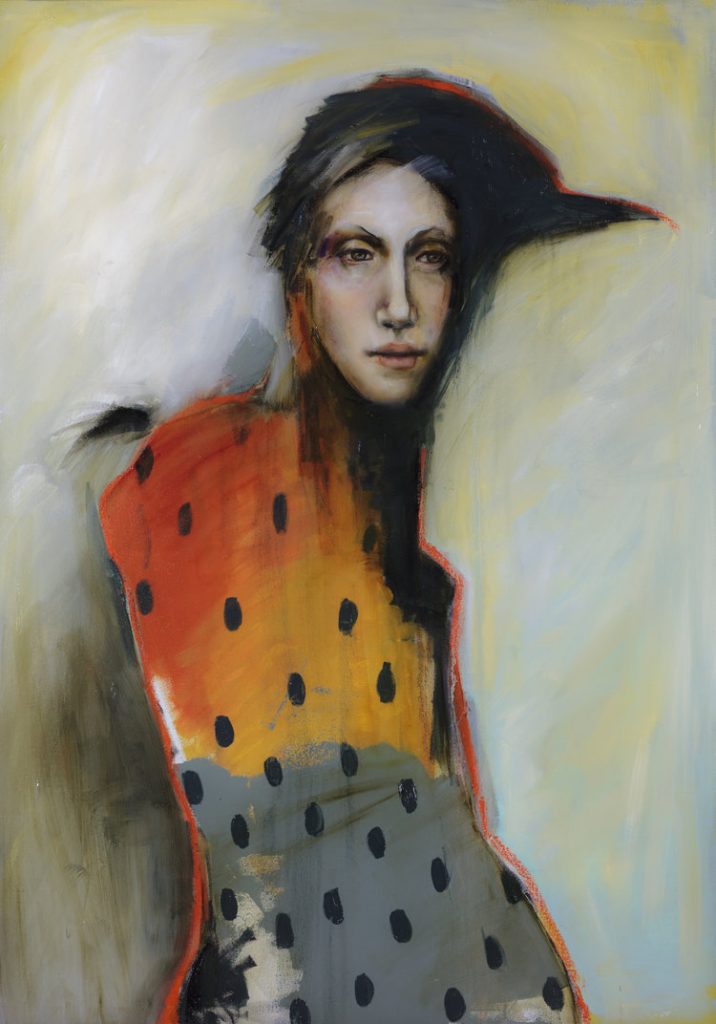
Michele Mikesell
October 31, 2021The Morrigan, 2017 by Michele Mikesell
Michele Mikesell’s characters peer back at you. Often, they seem to look through you. This is understandable as her inspiration is so often taken from mythology, with figures like this one (or ones, considering that the Morrigan is sometimes a trio, all sisters, called the three Morrígna) that embody larger ideas that dwarf the individual viewer. The imaginary portrait that Mikesell offers here is titled The Morrigan (but she / they are also called Mórrígan, sometimes named Morrígu, a powerful deity from Irish mythology. In Modern Irish she is Mór-Ríoghain, meaning “great queen” or “phantom queen”). A divinity of war and fate, often a harbinger who foretells doom, death or victory in battle, she’s often been depicted – as alluded to in the shadows here – as a crow (birds which still unsettle us as dark omens, or as scavengers of carrion, perhaps those who fall in battle….perhaps a psychopomp, even, waiting to escort the newly dead to their just reward…).
She looks fittingly unimpressed. (“It is better to fall in with crows than with flatterers; for in the one case you are devoured when dead, in the other case while alive.” – Antisthenes / Ἀντισθένης, c. 445 – c. 365 BC)
There’s a sense of whimsy to many of Mikesell’s anthropomorphic figures, blending animal and human, often titled for old gods like Artemis or Bastet. Another painting is titled Huginn, one of Odin’s ravens – another foreboding bird, knowing and seeing much. She lives in Dallas, Texas and Spain, and “her paintings hone in on the connectedness between human ideas and animal instinct. Irony, contradiction, humor and tragedy are themes throughout her work.”
Many more of her fine paintings (as it was very difficult to select just one) can be enjoyed here. ~ Bart Gazzola
Read More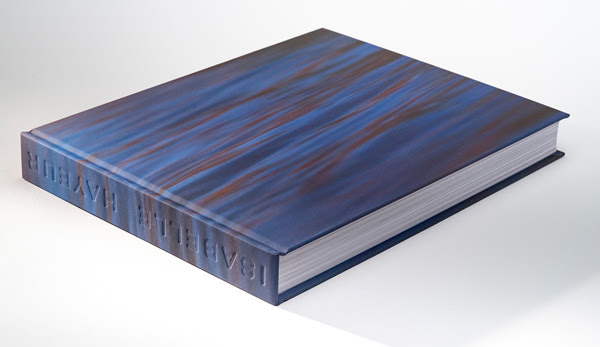
ISABELLE HAYEUR: Monograph
November 2, 2021ISABELLE HAYEUR: Monograph
By Mona Hakim, Peggy Gale, & Ann Thomas
Hardcover, 2020, 360 pages, available from Les éditions Plein sud
Texts in French and English $70 + Shipping
Committed to environmental causes since the 1990s, Isabelle Hayeur takes an acute critical look at the changes in our ecosystems caused by the devastating impacts of massive urbanization and industrialization on our territories.
This monograph, the most exhaustive publication to date on this artist’s work, leads us to the heart of her creative activity. Bringing together numerous visual documents, from her composite photo-graphs to portraits of citizen gatherings and activist groups by way of videos, installations in public spaces, and reflective texts, this richly illustrated book explores the vast production of an artist who has gained recognition in the contemporary art world, in Quebec and internationally. The texts present the reader with enlightened insights into the artist’s various accomplishments.
Read more about this monograph and order it here.
This recommendation appeared in the Fall 2021 – ECO ISSUE of PhotoED Magazine. If you’re looking for more Canadian photography inspiration check out PhotoED Magazine, in print + online https://www.photoed.ca
~ Rita Godlevskis
Read More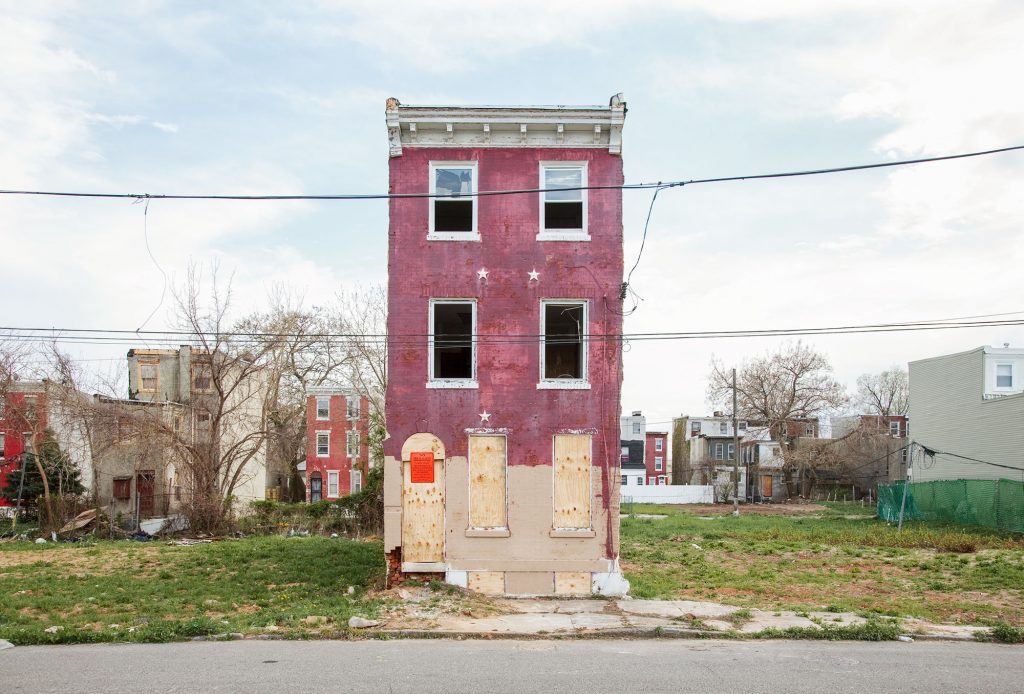
Philadelphia, PA, 2013 from Last House Standing by Ben Marcin
October 10, 2021
Philadelphia, PA, 2013 from Last House Standing by Ben Marcin
I spent a significant part of my formative years in the Windsor – Detroit area. When I visited Detroit, stepping outside of the immediate downtown into the areas that still bore the scars of history, I was often struck by singular houses – occupied or not, officially or otherwise – that stood like sentinels, like final gatekeepers, of areas that were empty and desolate. At that time, living near the Ambassador Bridge in Canada, the neighbourhood was picturesque and somewhat historic if a bit leaning towards dereliction: now, nearly three decades later, that section of Windsor is rife with shuttered houses, boarded up and abandoned.
Ben Marcin’s Last House Standing series is literally that: singular buildings, from Baltimore, New Jersey or – like this image – Philadelphia. These are all places with equally iconic stature as Detroit, and Marcin’s ‘figures’ alternately evoke gravestones or lone survivors, barely holding on, amidst the wastelands that have crept and grown up around them. Many seem like tombs; others bring an incongruous element of vitality with their vibrant colours, evoking T.S. Eliot’s ‘these fragments I have shored against my ruins’ (appropriately from his opus, The Wasteland).
Marcin also revisits sites. Thus, buildings that were barely holding on in 2011 are now gone, like they’ve never been, in 2020.
More of this series by Marcin can be seen here, at his site, or at his Instagram. ~ Bart Gazzola
Read More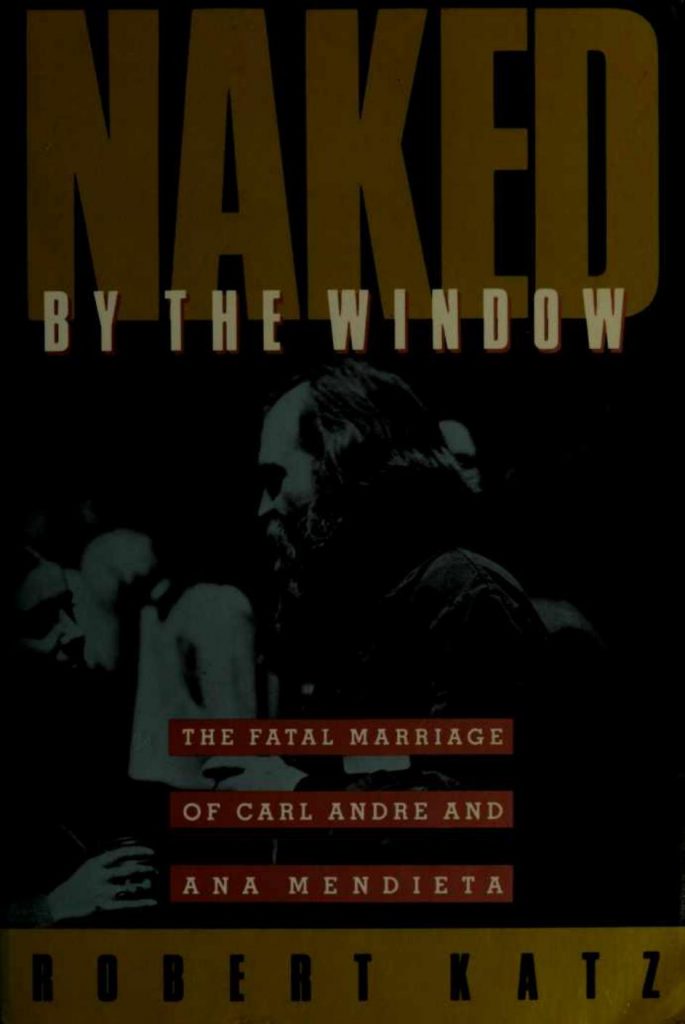
Naked by the Window: The Fatal Marriage of Carl Andre and Ana Mendieta
October 15, 2021Naked by the Window: The Fatal Marriage of Carl Andre and Ana Mendieta by Robert Katz
Considering the intensity around their relationship, the exponential growth of Ana Mendieta’s legacy and the fractious (perhaps overdue) repercussions resonating through the art world regarding institutional and more covert sexism, Naked by the Window: The Fatal Marriage of Carl Andre and Ana Mendieta by Robert Katz (1990) is a concise, factual book that eschews sensationalism for clarity.
A synopsis of the book offers a nod to this contested narrative: “In 1985, the charming, Cuban-born 36-year-old sculptor Ana Mendieta plunged to her death from the 34th-story Greenwich Village apartment she shared with her husband, the well-known and highly regarded artist Carl Andre”. Katz’ book “explores the turbulent personal and professional relationship between two highly regarded artists, drawing on numerous interviews and Mendieta’s papers to shed light on the mystery of her death.”
In 2015, Faheem Haider at Hyperallergic offered a response to the retrospective Carl Andre: Sculpture as Place 1958 – 2010 here that indicates how much – or how little – has changed in the four decades since Mendieta’s death. Haider is erudite but unflinching: Andre “was acquitted [of Mendieta’s murder], but the facts must be acknowledged in some way, whether as a curatorial position or a hard-line declaration. In the exhibition materials, in any statement related to this show, Mendieta — much less her death — is never mentioned at all.”
But art – like this book – exists outside galleries walls, too, and in 2010, a symposium titled Where Is Ana Mendieta? took place at NYU, marking the 25th anniversary of her death. This surely helped foment appropriate protest in response to Andre’s multi venue retrospective, as in May 2014, the feminist protest group No Wave Performance Task Force staged a protest in front of the Dia Art Foundation, ‘installing’ “piles of animal blood and guts in front of the establishment, with protesters donning transparent tracksuits with “I Wish Ana Mendieta Was Still Alive” written on them.” (Maria Crawford, from her article Crying for Ana Mendieta in response to the Carl Andre retrospective)
Katz’ book is well researched, well written and respectful of facts while not bending any of these truths to lead the reader (though he does offer an opinion, at the end, and it’s welcome in its lack of circumspection and resulting certitude).
Your local library or independent bookstore will surely have a copy, or can procure one for you.
~ Bart Gazzola
Read More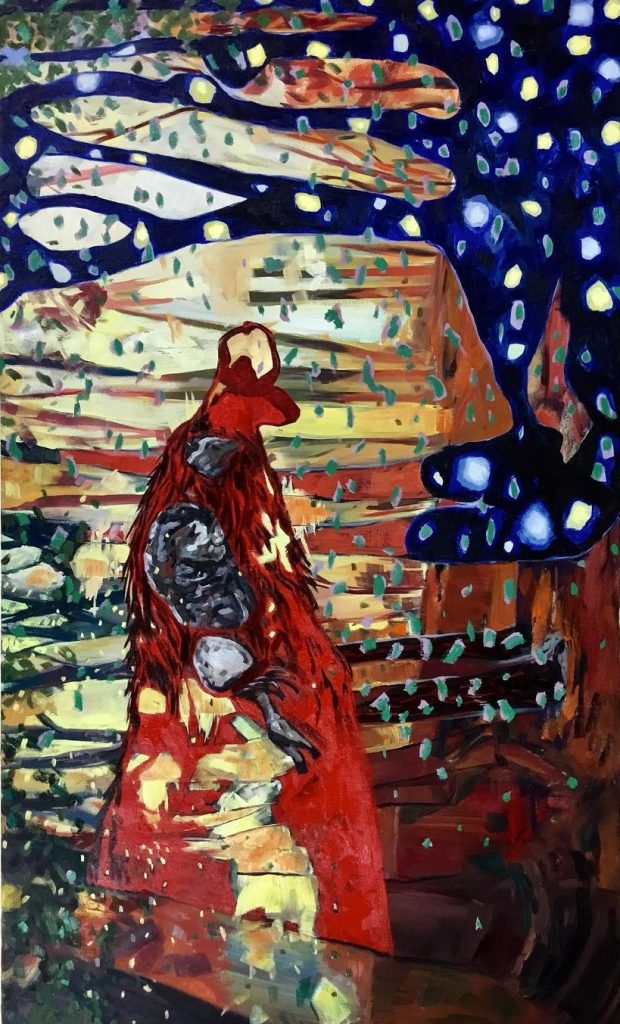
Throooom (a spell to wish away most days) – Scott Sawtell
September 21, 2021Scott Sawtell is a painter who straddles abstraction and symbolism, and the manner in which he applies paint means that repeated visits with his work may reveal aspects you missed previously. His works are often significant in size, and this painting is 3 feet by 5 feet, created in 2021 (I mention the size as often Sawtell offers scenes that we might step into, that although tumultuous and frantic, they have a vivacity and vividness that is inviting). One of a number of works currently installed at the Latcham gallery in Stouffville, his paintings offer the contradiction that they are individually seductive, and one can hold your attention, but as a group they create an environment, with pieces having a conversation, whether formally or with some of the narratives Sawtell alludes to, with rough forms or poetic, yet sly, titles.
Recently I’ve been engaging with the work of another painter, Tony Calzetta, and an observation about his work is apt here: there is the possibility of narrative in this painting, but not the necessity of it. It’s also worth considering Julian Bell’s remarks from his book What Is Painting? Representation and Modern Art : ‘In other words there was no prior context to the painting itself. The viewer’s eyes would submit, and the painting would act.’
More of Sawtell’s work can be seen here, at his site, and on his Instagram. ~ Bart Gazzola
Read More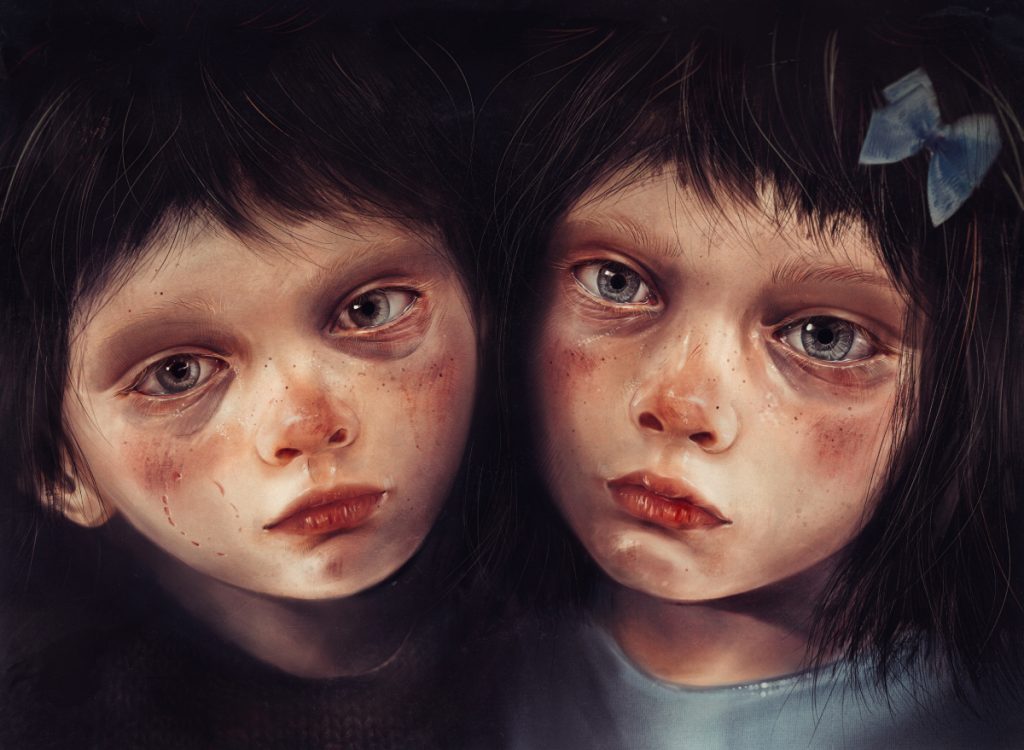
The Mark – Olga Volgina
August 24, 2021One of Olga Volgina’s more recent works that she’s shared on social media (as she’s a prolific artist) is a work that resonates in both an immediate and historical manner. Any (well made and meaningful) rendering of children has this power. Volgina’s children evoke a multiplicity of intersecting references: Goya’s portrait of Manuel Osorio Manrique de Zúñiga, who looks doll – like and innocent until a closer examination reveals several cats waiting to devour his pet bird, to the child’s indifference, is one. Delving even deeper into the worn faces and unflinching gaze of the children, I’m also reminded of Robertson Davies’ book World of Wonders. In response to one character relating his harsh yet essential childhood experiences, another defers that though he has experience “exploring evil” through his films, the evil of children is something that requires courage he lacks….
Volgina’s children must also bring to mind Ignorance and Want, from Dickens’ A Christmas Carol, and in that instance offer a more disturbing consideration of how a child is perhaps a larger reflection (or repository) for the world in which they live. Volgina commented that when this work – titled The Mark – was finished, “now I look at them and they look at me”, but what they see, or what they think, is opaque to us. We can guess; but the children in The Mark are silent and staring, offering no answers. Perhaps they’re indifferent to us, perhaps demanding, or perhaps simply exhausted and bruised.
Volgina lives and works in St. Petersburg, Russia. Her digital portraits, as she describes them, are both a bit unsettling and insightful. This brings to mind how sitting for some artists requires a degree of courage (never mind being nude but what of the deeper self that the artist might excavate and present for the world to see?).
See more of Olga Volgina’s work on Instagram, FB and at Etsy, where she and her twin sister, Liza Volgina, have a variety of engaging works on display. ~ Bart Gazzola
Read More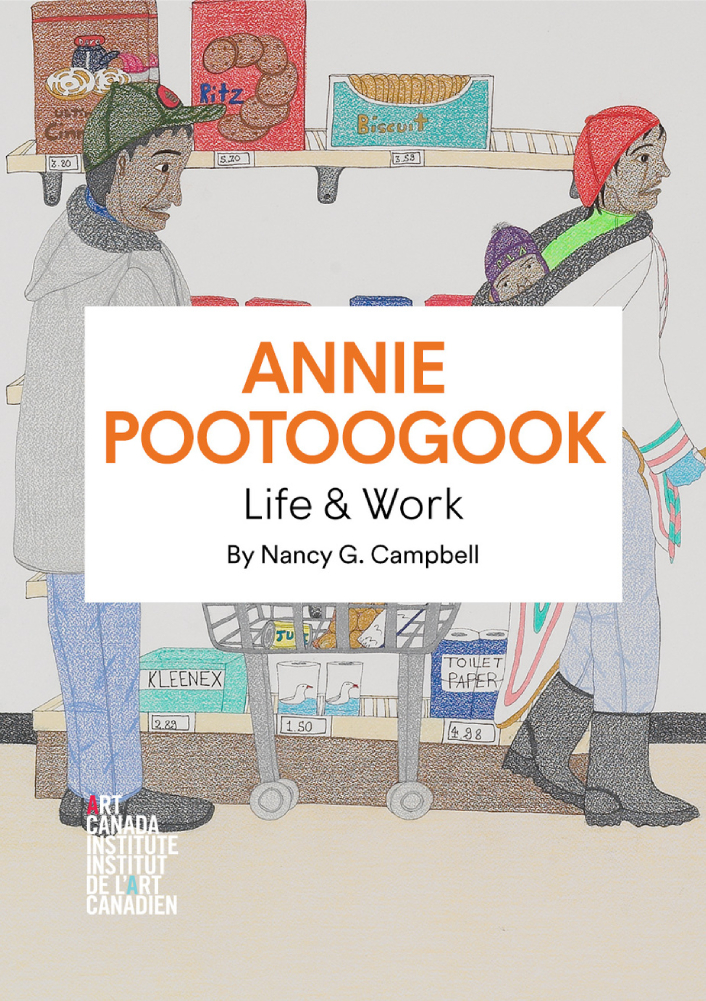
Annie Pootoogook | Life & Work
September 30, 2021Annie Pootoogook | Life & Work by Nancy G. Campbell
The Art Canada Institute has produced a number of fine books (all readily available at their site) on various artists that have informed and challenged the larger Canadian art world.
Nancy G. Campbell’s “Annie Pootoogook: Life & Work traces the artist’s life from her youth at the West Baffin Eskimo Co-operative’s Kinngait Studios, where she began drawing in 1997, predominantly in ink and crayon, to her death in 2016. The book explores how in addition to depicting scenes of everyday life in the North—including people watching TV, playing cards, shopping, or cooking dinner—Pootoogook depicted such subjects as alcoholism, domestic abuse, food scarcity, and the effects of intergenerational trauma.”
There is a certain bluntness and brutality, at times, to Pootoogook’s scenes. Campbell’s engaging but also rigorous examination of Pootoogook’s life and work (as they were, frankly, one and the same) explores how “the life of Annie Pootoogook (1969–2016) tells an important national story, and her career marks a pivotal shift in the national consciousness around contemporary Inuit art. With a keen eye for detail and fearlessness in representing daily life—the celebratory, the frightening, and the mundane—she captured the attention of Southern audiences. Although imported culture and technologies have dramatically changed Inuit life, the North has also stayed true to tradition: community, food, and language remain sources of Inuit pride. In her drawings, Annie depicted what is still valued and unique in her culture and what is changing rapidly. She had a meteoric rise in the art world that was tragically cut short when she died in 2016.”
I encountered Pootoogook’s work at the Mendel Art Gallery (now the Remai Modern) in Saskatoon in 2009. The simplicity and directness – the truth, both celebratory and unsettling – of her images resonated in that place. From the legacy of residential schools that dotted the prairies, to the Saskatoon police’s starlight tours, to the ongoing shameful dismissal of murdered and missing Indigenous women, Pootoogook – though from Cape Dorset – was very loud, in Saskatchewan, and even posthumously has a power to disrupt our assumptions and ignorance.
Annie Pootoogook: Life & Works, a publication from The Art Canada Institute, can be read here.
More about Pootoogook can be read here.
Read More
Recent Comments